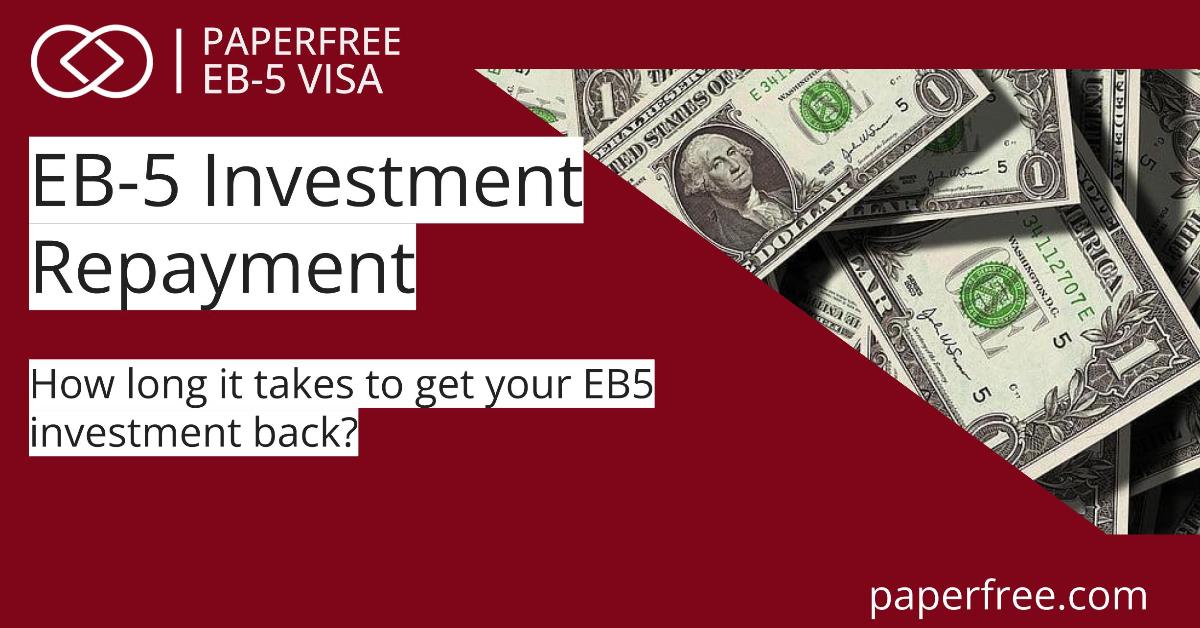PAPERFREE
investment visa
FREE CONSULTATION
EB-5 Investment Repayment | How Long Does it Take to Get EB-5 Investment Back?
Explore the timeline for receiving your EB-5 investment with our comprehensive guide. Learn about factors influencing repayment duration and common FAQs regarding this critical aspect of the EB-5 program.last updated Monday, December 22, 2025
#EB-5 Investment Repayment #EB-5 program repayment
| | by Sidra Jabeen |

QUICK LINKS
AD
Get Access to EB 5 Visa Investment Projects
Understanding the EB-5 Investment Exit Strategy and Repayment Process
One of the key factors that determine the success of an EB-5 investment is the EB-5 investment exit strategy. This strategy outlines how and when investors can expect to receive their capital back, and it is essential for ensuring a smooth EB-5 loan repayment. Whether you have invested through a loan-based model or an equity-based model, the EB-5 visa investment payback will depend heavily on the project's performance and the fulfillment of its job creation goals.
The EB-5 funding repayment process typically occurs after the investor completes the two-year conditional residency period, assuming all USCIS requirements have been met. It is crucial to understand the EB-5 investment refund conditions requirements, as failure to meet these conditions can result in delayed repayment or even loss of the invested capital.
Working with experienced EB-5 specialists can help investors navigate the complexities of the EB-5 visa investment return. These specialists can provide valuable insights into the best investment strategies and help ensure that the exit strategy aligns with your investment goals. Whether you are looking for a stable, predictable return through loan repayment or a potentially higher return via equity investments, a well-structured EB-5 investment exit strategy will guide you through the entire process.
Investors should always consider the EB-5 investment refund conditions requirements before committing to a project. Ensuring that the project meets these conditions and has a clear repayment strategy will maximize your chances of receiving a timely EB-5 loan repayment and ultimately achieving a successful EB-5 visa investment payback.
EB-5 Investment Repayment: What Investors Need to Know
The EB-5 Immigrant Investor Program provides a pathway to U.S. residency for foreign investors by offering an opportunity to invest in job-creating projects. As the program continues to evolve, understanding the EB-5 investment repayment process is crucial for potential investors. This article explains everything you need to know about EB-5 investment repayment, the factors that affect it, and how to maximize your returns from EB-5 investments.
What is EB-5 Investment Repayment?
EB-5 investment repayment refers to the process through which investors receive their principal investment back after fulfilling the program's requirements. These requirements include creating jobs for U.S. workers and maintaining the investment "at risk" for a set period. Typically, repayment takes place after the investor has completed their two-year conditional residency and the EB-5 project has met its job creation goals.
Here's a clear overview of how EB-5 repayment works, typical timelines, and key factors affecting repayment:
EB-5 Investment Refund Conditions and Requirements
The EB-5 investment refund conditions and requirements are governed by the terms of the investment, USCIS guidelines, and the success of the underlying project. Investors must ensure that the funds are “at risk” for the entirety of the conditional residency period. The repayment timeline typically spans between 5 to 7 years, but several factors can influence this period, including USCIS processing delays, visa retrogression, and project performance.
Factors Influencing EB-5 Investment Repayment
Several critical factors can affect when and how an investor receives their EB-5 investment refund.
These include:
- Project Success
The financial health and performance of the EB-5 project directly impact repayment. Projects that fail to create the required number of jobs or experience financial difficulty could delay repayment. - Investment Type
The structure of the investment plays a significant role in repayment:- Loan-based EB-5 investments tend to have predictable repayment terms with lower risk.
- Equity investments and direct EB-5 investments, while potentially yielding higher returns, come with greater risk and variable repayment schedules.
- USCIS Delays
The EB-5 program repayment timeline can be extended if there are delays in processing your visa application or if you experience visa retrogression due to high demand from countries like China and Vietnam. - Exit Strategy
Every EB-5 project has a well-defined exit strategy, which dictates when and how investors will get their money back. This is especially important to understand upfront to avoid surprises.
Typical EB-5 Investment Repayment Timeline
For most EB-5 projects, investors can expect to see their investment repaid within 5 to 7 years. Here is a breakdown of the typical timeline:
- Initial Investment and Green Card Approval
The clock starts ticking once the investor makes the EB-5 investment and receives their conditional green card. - Two-Year Conditional Residency Period
During this time, the investor must maintain their investment and ensure that the project fulfills its job creation requirements. - Repayment Begins
Following the conditional residency period, repayment usually begins, assuming the project meets the necessary job creation goals and is financially viable. - Full Repayment
Full repayment of the investment typically occurs between 5 and 7 years, depending on the project’s financial health, exit strategy, and USCIS processing times.
| Aspect | Details |
|---|---|
| Typical Repayment Time | 5 to 7 years after investment |
| Repayment Condition | Project success and job creation |
| Investment Types | Loan-based (more predictable), equity (higher risk) |
| Impact of USCIS Delays | May extend residency and repayment timeline |
| Guarantee | No guaranteed repayment; investment must remain at risk |
| Due Diligence | Essential to review exit strategy and regional center track record |
Redeployment of EB-5 Invested Capital
Given recent delays in USCIS processing times and visa retrogression, the redeployment of EB-5 invested capital may be necessary in some cases. If an investor’s conditional residency is extended or the project's repayment timeline exceeds the initial agreement, redeployment ensures that the capital remains in a lawful business venture and continues to meet the EB-5 eligibility criteria.
When is Redeployment Necessary?
- Delays in I-526 Approvals
If the I-526 petition is delayed, it may push the repayment timeline beyond the original agreement. - Prolonged Conditional Residency
In situations where the residency period extends beyond the project's loan term, redeployment helps maintain compliance. - Completion of Original Business Plan
If the business plan is finished but the residency requirement isn't met, the investor may redeploy funds into a new project.
Types of EB-5 Investments and Their Returns
The EB-5 program repayment varies depending on the type of investment made. Here’s a closer look at the EB-5 investment return for different investment structures:
1. Loan-Based EB-5 Investments
- Structure: Loan-based investments are structured like traditional loans, with fixed repayment terms.
- Return on Investment (ROI): Loan-based investments generally offer predictable returns with lower risk and are often preferred by investors looking for stability.
- Best For: Investors who seek steady, moderate returns with a clear exit strategy.
2. Equity-Based EB-5 Investments
- Structure: In this model, the investor holds equity in the project and shares in the profits and losses.
- ROI: The potential for higher returns exists, but these are not guaranteed, and the risk is higher compared to loan-based investments.
- Best For: Investors who are willing to take on more risk for the possibility of higher returns.
3. Direct EB-5 Investments
- Structure: Investors directly invest in a commercial enterprise and may manage its operations.
- ROI: This model offers the highest potential returns but involves substantial risk and requires active management.
- Best For: Experienced investors who want more control and are comfortable with greater risks.
EB-5 Regional Center Investment Return
Choosing the right EB-5 regional center investment return is essential for maximizing the chances of repayment. Reputable regional centers have a proven track record of success, which increases the likelihood of timely repayment. A well-managed regional center can offer detailed business plans, solid exit strategies, and transparent communication, all of which contribute to a positive investment experience.
Redeployment of EB-5 Invested Capital
Due to increased USCIS processing times, heightened visa demands, and visa retrogression, particularly for applicants from countries such as China and Vietnam, the redeployment of EB-5 invested capital may become necessary. USCIS mandates that EB-5 funds remain "at risk" throughout the investor's two-year conditional residency period, meaning the capital cannot be returned prematurely. If there are delays in I-526 approvals or if the conditional residency period extends beyond the project's loan terms, investors may need to redeploy their capital into another lawful commercial business activity. This ensures compliance with USCIS requirements and maintains the investment's eligibility under the EB-5 program.
When Redeployment is Necessary
- Delays in I-526 Approvals: Extended processing times can push the repayment timeline beyond initial projections.
- Prolonged Conditional Residency: If the residency period extends beyond the project's loan terms, redeployment helps maintain compliance with the terms.
- Completion of Original Business Plan: If the original business plan concludes and the investor still needs to fulfill residency requirements, redeploying funds into another lawful business activity is allowed.
Redeployment Guidelines
- Lawful Commercial Business Activity: Investors must invest in a lawful business venture that is not purely financial, such as a business venture that involves securities or financial instruments on the secondary market.
- Exclusion of Financial Activities: Redeployment into purely financial activities is prohibited, ensuring that funds are invested in tangible business operations and not speculative investments.
Risks and Due Diligence in EB-5 Investments
While the EB-5 program offers significant opportunities, it also has inherent risks. Investors need to work with EB-5 Consultants, conduct thorough due diligence, and carefully weigh the risks and advantages before committing their capital. Here are some critical considerations:
Inherent Risks
- No Guaranteed Returns: Unlike traditional investments, EB-5 investments do not guarantee the return of principal or expected returns.
- Project-Specific Risks: The success of the investment is tied to the project's performance, market conditions, and management efficiency.
- Regulatory Changes: Changes in immigration laws or EB-5 regulations can impact investment terms and repayment timelines.
Conducting Due Diligence
- Evaluate Regional Centers: Partner with reputable regional centers that have a track record of successful EB-5 project completions.
- Review Business Plans: Ensure that the project's business plan is robust, with clear job creation metrics and a well-defined exit strategy in place.
- Assess Financial Projections: Analyze the financial projections and repayment plans to understand the potential ROI and timeline.
- Legal Consultation: Engage with an immigration attorney who specializes in EB-5 to navigate complex regulations and safeguard your investment.
Maximizing Your EB-5 Investment Repayment
To maximize your EB-5 investment return, consider the following strategies:
- Choose Reputable Regional Centers
Regional centers with a proven track record can provide more reliable returns and better management of your investment. - Conduct Comprehensive Due Diligence
Review the business plan, project feasibility, and exit strategy before committing to an EB-5 investment. - Understand the Exit Strategy
Ensure that the project has a clear, structured exit strategy, which will help you manage expectations regarding repayment timelines. - Seek Professional Legal and Financial Advice
Engage with experts to navigate USCIS regulations and understand the implications of investment choices on your EB-5 program repayment.
Frequently Asked Questions
How long does it take to get my EB-5 money back?
The repayment typically occurs within 5 to 7 years, after the completion of the two-year conditional residency period.
Is EB-5 repayment guaranteed?
No, repayment is not guaranteed. The investment must remain "at risk," and repayment depends on the project's success.
What happens if the business plan is completed before my residency requirements are met?
If the business plan concludes before the residency requirement is fulfilled, investors may need to redeploy their capital into another lawful commercial business activity.
How do USCIS delays affect the repayment process?
USCIS delays can extend the conditional residency period, potentially delaying repayment. Investors may need to redeploy funds to comply with the "at risk" requirement.
What types of EB-5 investments offer the best return?
Loan-based investments offer predictable returns with lower risk, while equity-based investments offer higher potential returns but come with higher risk.
Book Your Free Consultation with Paperfree EB-5 Visa Experts. Get Personalized Advice and an Investment Plan. Book Your Free Consultation Today!

Conclusion: Maximizing Your EB-5 Investment Repayment and Returns
In conclusion, understanding EB-5 Investment Repayment is essential for navigating the complexities of the EB-5 visa program. While EB-5 investment refund conditions and requirements are clearly defined, repayment is largely influenced by the success of the project, the type of investment, and various external factors such as USCIS delays. As investors, ensuring compliance with the EB-5 program repayment guidelines and staying informed about the redeployment of EB-5 invested capital can help avoid delays and ensure that your investment remains "at risk" during the required period.
For those seeking to maximize their EB-5 investment return, the choice between loan-based investments, equity investments, or direct EB-5 investments plays a significant role in the repayment timeline and potential returns. The EB-5 regional center investment return depends on selecting reputable centers with a strong track record of delivering successful projects. Additionally, understanding the EB-5 projects return on investment and assessing the risks of EB-5 loan payback can help investors make more informed decisions.
It's important to recognize that no EB-5 money back guarantee exists, as the program requires investments to remain "at risk" to meet USCIS eligibility criteria. By carefully evaluating each project’s potential for success and understanding the full scope of the EB-5 program repayment process, you can optimize your investment and ensure that you are on track to achieve the best possible outcome from your EB-5 visa investment.
The EB-5 Visa program remains a significant avenue for foreign investors seeking residency in the United States. The recent increase in visa availability, particularly in high-unemployment and rural areas, underscores the program's ongoing relevance and stability. For more detailed information and personalised guidance, visit Paperfree.
Free Investment Visa Consultation
Paperfree Investment Visa Social Channel - Instagram
Pages Related to: EB-5 Investment Repayment, EB-5 program repayment
- Papefree EB5 investors magazine your source for EB5 insights. EB5 News.

- Set Aside EB-5 Visas Benefits and Advantages

- EB-5 Regional Center Program 2027 Expiration: Secure Your Green Card Before Deadline | Renewal Updates

- EB-5 Investment Protection: How Experienced Developers Safeguard Your Capital | Paperfree

- Joseph Edlow Confirmed as New USCIS Director

- EB 5 due diligence checklist. EB-5 due diligence process.

- EB-5 Funding 3.0 for Investors | EB5 Visa

- EB5 source of funds | Best Practices for Currency Swap

Popular for the Investment Visa Program
Benefits of the EB-5 Visa Program | Guide
